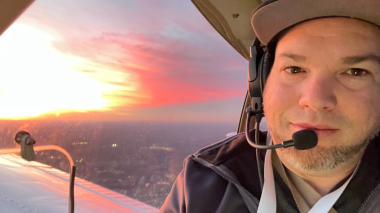Scoliosis is a common condition that affects many children and adolescents. Instead of a straight line, a spine with scoliosis curves. Brian Scannell, MD, orthopedic surgeon at Levine Children’s Hospital, breaks down key facts about scoliosis as well as the signs and symptoms that every parent should know.
1. What is a spinal disorder?
A spinal disorder is an all-encompassing term for a variety of spine problems in pediatric and adolescent patients. This includes disorders of the bony portion of the spine as well as the spinal cord itself. Each segment of the spine is crucial to the health of the entire spinal column and cord. Our goal is to make sure that all portions of the spine function correctly to allow for a healthy and active life.
2. What is the most common kind of spinal disorder treated at Levine Children’s Hospital?
We most frequently see patients with scoliosis, which occurs most often in children between the ages of 10 and 18. Scoliosis also affects children at a very young age as well as patients with neuromuscular disorders such as cerebral palsy and muscular dystrophy. Other spinal disorders we see include kyphosis, spondylolysis and spondylolisthesis in children and adolescents.
3. What is scoliosis?
Scoliosis is a three-dimensional deformity that causes the spine to curve from side to side, making an ‘S’ shape. The cause of scoliosis is unknown. However, the condition can be hereditary, so a child who has scoliosis might have family members who have it.
There are a number of things that we look for when diagnosing scoliosis:
- One shoulder that is higher than the older
- Trunk or ribcage that shifts to one side
- Asymmetry at the waist
- One shoulder blade that is more prominent than the other
4. How do you treat scoliosis?
There are a variety of treatments used to treat scoliosis. The correct treatment is determined by the size of the curve, the age of the patient and how much growth the child has left.
I typically talk to families about three options:
- Observation – continue to monitor every four to 12 months
- Bracing – for moderate curves in children with growth left
- Surgery – for severe curves
To help us decide the best course of treatment, we measure the curvature of the spine in degrees. A scoliosis curve of 10 to 15 degrees usually means that nothing needs to be done except for regular checkups until puberty and growth are complete, as the curvature of the spine usually doesn’t get worse after that point. If the curve is 20 to 40 degrees, I will generally suggest a back brace. An angle of 40 or 50 degrees or more may mean that surgery is necessary.
5. How do you determine if a patient will require surgery to correct scoliosis?
We typically recommend surgery when scoliosis is large enough to progress into adulthood. Problems associated with untreated large curves in adulthood are issues with breathing and pain.
The recommended timing and type of surgery will depend a lot on the age of the child. In adolescent idiopathic scoliosis, curves less than 45 to 50 degrees do not tend to progress in adulthood. However, curves above this threshold do tend to progress, which is why we frequently recommend surgery. The goal of surgery is to correct the spine as much and as safely possible, and to prevent progression of the scoliosis.
With other spinal conditions, treatment is very specific to the patient and their condition. We first focus on conservative management prior to proceeding with surgery.
6. Will a spinal disorder stunt my child’s growth?
By the time a child reaches adolescence, their trunk growth is nearly complete and the majority of the remaining growth occurs in the legs. So in these children, surgery for scoliosis typically doesn’t affect growth. In younger children, those under the age of 10, the truncal growth is not complete. Therefore, there are other surgical options that still allow for growth of the spine. However, children who have interventions early frequently require repeat surgeries for “lengthening” their spine.
7. How can I talk to my child about his or her condition?
I always encourage parents to talk with their child after an initial office visit. Often times, a teenager will not want to ask the doctor a lot of questions. I recommend the family discuss the situation at home and write down any questions they have, then ask the doctor at the next visit or over the phone. Parents, children and physicians need to work together to make decisions for treatment, and open communication is the best way to address this.
8. How often will my child need to see his or her doctor?
This will vary from patient to patient. For observation or after initiation of a brace, I see patients every four to six months for repeat exams and X-rays.
9. Can my child play sports and participate in other activities?
Nearly all patients can return to sports. Most surgeons prefer that children not return to major contact sports, such as football, after surgery, but if I am treating a child with braces or observation, I let them continue all activities as tolerated with no restrictions.
10. Are there any long-term effects?
- From scoliosis surgery:
- Typically, there are no long-term effects. The section of the spine that is surgically fused is no longer flexible, but if it is in the thoracic spine this doesn’t have much of a long-term effect. We try to preserve as many lumbar segments as possible to allow natural motion after surgery.
- From scoliosis without surgery:
- Research that has been done on small-to-moderate curves shows that patients with scoliosis have no long-term effects other than increased risk for back pain. Larger curves may affect pulmonary function and cause deformity.
The management of scoliosis has evolved significantly over the past decade. Levine Children’s Hospital has all of the tools to help educate and manage patients with spinal deformity. Your child’s doctor may refer you to see a pediatric orthopedic specialist, or you can schedule an appointment with us directly by calling (704) 381-8870.



